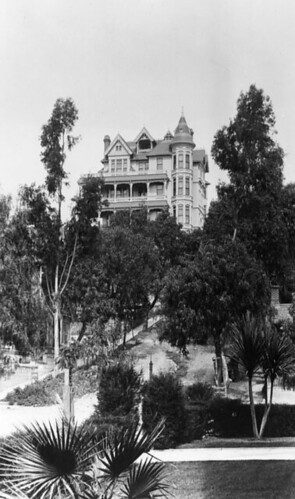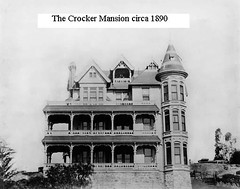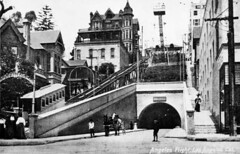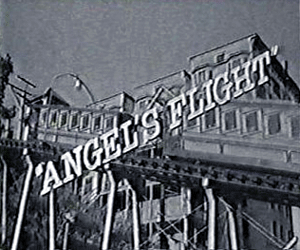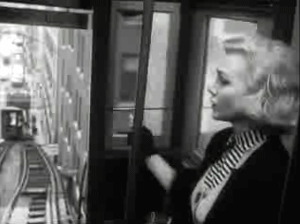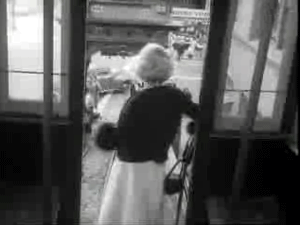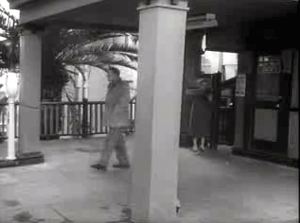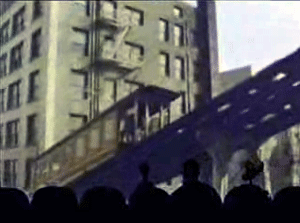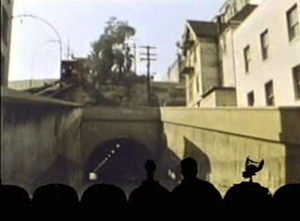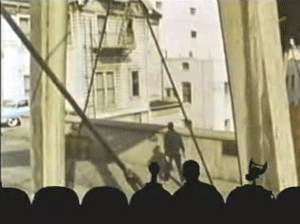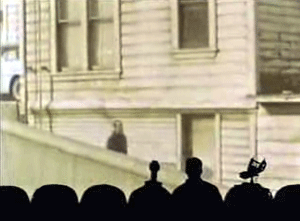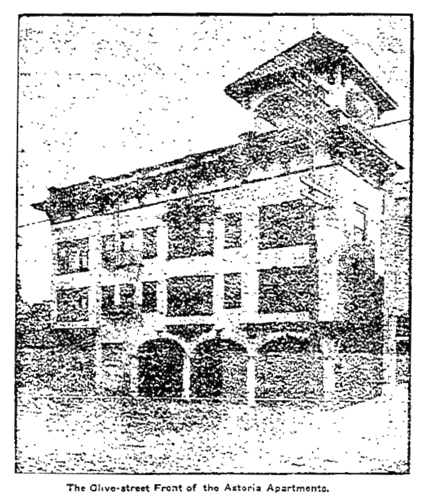
The Astoria Apartments”¦the advantages of the city‘s tourist hotels with the quiet of the residence section. Plus, at no extra charge to you, grewsome murder.
The Astoria contains over 125 guest rooms, beautifully furnished. Many are en suite, with parlor, bedroom and bath, dining-room and kitchen. A number of single rooms are also provided, both with and without private bath. Among the attractive features of the Astoria is the beautiful view of the city to be obtained from practically every room of the building. A spacious office and lobby, a dainty ladies‘ reception-room, and a dancing hall are some the features which have been provided by E. W. Smith, the owner of the building. These are handsomely decorated and furnished, and will undoubtedly serve to make the Astoria popular.
–December 17, 1905
Before Bunker Hill hit its cinematic skids, t‘was the place of purloinery more aligned with the tony climes of Monte Carlo than El Monte: cat-burgling jewel thieves were at 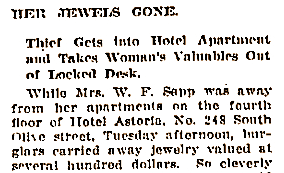 work! In October of 1911, Astoria resident Mrs. W. F. Sapp returned to her room one afternoon to find”¦nothing amiss. But her mother, Mrs. W. W. Loomis, of the adjoining apartment, called attention to having heard her daughter next door at her writing desk while said daughter was supposed to be absent. They opened the locked writing desk”¦to behold”¦gasp! The chatelaine bag, lockets and bracelets and the like were gone, as was the ancestral family tin box (found later in the lavatory, a can opener found on the fifth floor above) once filled with gold watches, fobs, and diamond-set pieces, now scattered to the underworld of crooked, loupe-wearing bangle merchants.
work! In October of 1911, Astoria resident Mrs. W. F. Sapp returned to her room one afternoon to find”¦nothing amiss. But her mother, Mrs. W. W. Loomis, of the adjoining apartment, called attention to having heard her daughter next door at her writing desk while said daughter was supposed to be absent. They opened the locked writing desk”¦to behold”¦gasp! The chatelaine bag, lockets and bracelets and the like were gone, as was the ancestral family tin box (found later in the lavatory, a can opener found on the fifth floor above) once filled with gold watches, fobs, and diamond-set pieces, now scattered to the underworld of crooked, loupe-wearing bangle merchants.
But not all crimes at the Astoria were so quaint.
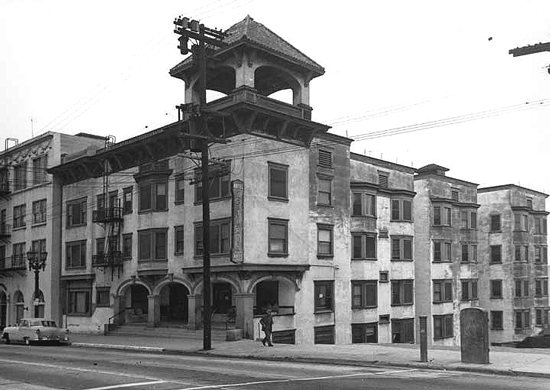
Edna A. Worden lived in the Astoria. Forty-eight, New Hampshirite, kept to herself mostly, known around the place as a woman of culture and refinement. Kept the bookshelves of her one-bedroom in the Astoria lined with Shakespeare, Milton, Dante, Dickens, Byron, Poe, the Greek philosophers, and many a Bible. She made a meager wage as a WPA worker, and with the monthly $30 sent to her by her ex-husband back east, made a good life for her and her twelve year-old daughter Marguerite.
Marguerite, a student at Belmont Junior High School who, had she made it to Monday, was to have entered a Beverly Hills school for girls.
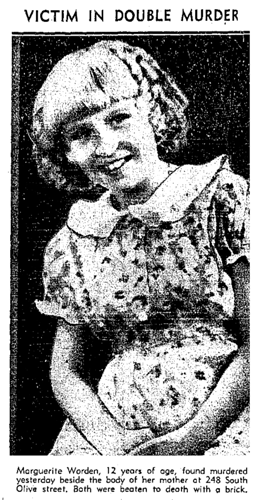 Sunday, April 4, 1937. Little Marguerite made a habit of always coming down to the desk to borrow the Sunday paper. This morning she did not. A concerned John Riley, the elevator operator, put an ear to the Wordens‘ door and ascertained a low moan; he summoned Astoria manager J. E. Harrigan, who, with his trusty stepladder, peered through the transom. After what he saw police arrived in short order and even hardened Detective Lieutenants Ledbetter, Bryan and Lopez, after kicking in the door, had to halt in their tracks at the horror that lay in wait.
Sunday, April 4, 1937. Little Marguerite made a habit of always coming down to the desk to borrow the Sunday paper. This morning she did not. A concerned John Riley, the elevator operator, put an ear to the Wordens‘ door and ascertained a low moan; he summoned Astoria manager J. E. Harrigan, who, with his trusty stepladder, peered through the transom. After what he saw police arrived in short order and even hardened Detective Lieutenants Ledbetter, Bryan and Lopez, after kicking in the door, had to halt in their tracks at the horror that lay in wait.
Edna lay sprawled over a cot in an array of splatter, her head against the floor. Marguerite was on the bed, her head covered with a pillow, topped with a discarded brickbat, mortar glued to its sides, sticky with blood and gore. The room was cluttered, revealing a desperate struggle during their sexual assaults and skull shatterings. Edna‘s purse was turned inside-out, otherwise, the room was unrifled–Marguerite‘s mute witness rag doll, her ivory-bound prayer book with a shiny dime atop, her freshly washed and ironed blue gingham dress on a nail above the bed. The fates conspired to aid their attacker; on one side of the apartment was a storeroom, on the other, the apartment of old Harry Tutin, partially deaf.
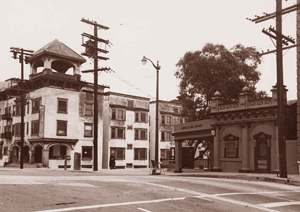 The Wordens’ attacker or attackers had climbed the Angels Flight stairs and forced entry through the kitchen window just below Olive Street. Shoes were removed before climbing in–traces of sock wool were removed from the plaster casts. (The feet, size eleven.) The assailant is almost certainly responsible for the March 2nd rape and brick-administered basal skull-smashing of Rose Valdez, 20, attacked while her year-old baby slept in a crib by her side.
The Wordens’ attacker or attackers had climbed the Angels Flight stairs and forced entry through the kitchen window just below Olive Street. Shoes were removed before climbing in–traces of sock wool were removed from the plaster casts. (The feet, size eleven.) The assailant is almost certainly responsible for the March 2nd rape and brick-administered basal skull-smashing of Rose Valdez, 20, attacked while her year-old baby slept in a crib by her side.
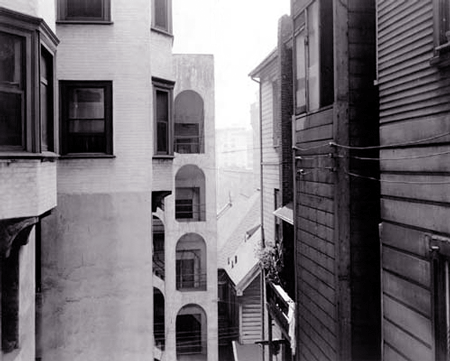
Bunker Hill was blanketed by the entire homicide squad assigned to all-night duty, with four squads of regular detectives and fifty men from Metro combing the City for suspicious Black Men–not exactly racial profiling, since it was a black man who ran from the scene of the attempted January 25 brick-attack on Mrs. H. W. Koll in Monte Sano hospital; the February 3 Barclay hotel room skull fracturing of Elizabeth Reis (again, leaving his brick behind); and the March 28 Zoe Damrell attack in her home at 1026 Ingraham, she left barely alive by a brick-bearing assailant who bore remarkable resemblance to the large black gentleman seen lurking by the Valdez house immediately before her murder.
Assorted Los Angeles sickos–alleged–were brought in for questioning, their faces and addresses plastered throughout the papers (doubtlessly tarnishing their lives forevermore) but all were cleared, not only through their alibis, but because the Worden killer had the bad fortune of leaving something else behind besides his brickbat: before putting on his gloves, he moved a milk bottle. Fingerprint central.
So if the killer skipped town, there‘s a good chance he could have, would have never been caught. But a certain Robert Nixon just had to kill women. With bricks. This time in Chicago, on May 28, 1938, the nineteen year-old Nixon brick‘d Mrs. Florence Johnson, wife of a Chicago city fireman, and gets popped for it, and confesses. A little digging revealed that during the time of the Worden and Valdez killings, he lived at 803 South Central Avenue.
Nixon initially denied involvement with the crimes, but after LA Police Chief Davis announced that comparison of fingerprints made positive identification of Nixon, Nixon admitted to the whole brick-laden shebang–the Wordens and Valdez, plus the Chicago murders of Mrs. Florence Thompson Castle in her hotel room in 1936, and the rape/murder of student nurse Anna Kuchta in August 1937, and assaults on at least seventeen other women.
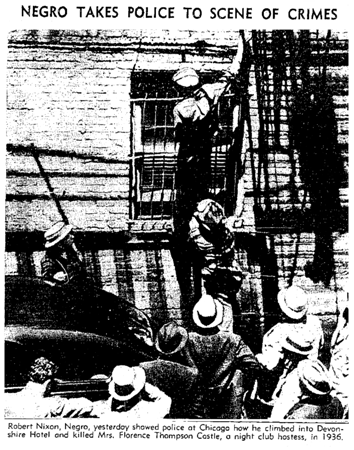
In June 1938, Howard Jones Green, Nixon‘s sometime accomplice, was shipped from Chicago to view the murder scene at the Astoria. He admitted to beating little Marguerite on the head (with his pistol butt, and not the brick) but denied partaking in the sexual assault, and admitted they grossed all of eight dollars from the venture. He ‘fessed up to the March ‘37 Zoe Damrell attack and for that was given five to life; what became of his Marguerite trial we‘re not told.
On June 16, 1939, Robert Nixon went to the chair at the Cook County Jail. Thus, he did not live to read 1940‘s smash lit-hit Native Son, which explained that his predicament was destiny, a societal byproduct of racist racial conditioning. So argued the lawyer for Native Son‘s protagonist Bigger Thomas, accused of killing a white woman in Chicago, as penned by Richard Wright, who made great use of the sensationalistic Robert Nixon newspaper reporting at the time.

Less than a decade later, plans were underway to remove every trace of Bunker Hill’s 136 acres from existence. After a four million dollar increase in annual taxes, and a grant from the federal Urban Renewal Program, oil tycoon William T. Sesnon Jr. finally began his twelve-year-in-the-making dream of wholesale land acquisition in October 1960. Nine thousand persons were eventually displaced, and the first building to be demolished was the Astoria‘s neighbor, the Hillcrest, in September 1961. The Astoria went soon after. The land sat barren for eighteen years until the federally subsidized, Dworsky modular prefab Angelus Plaza (designed with a 1200′ People Mover) broke ground in 1979.

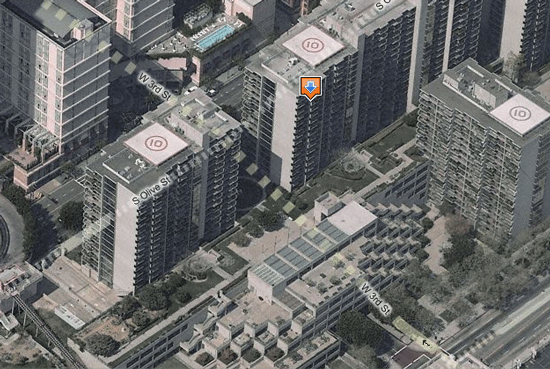
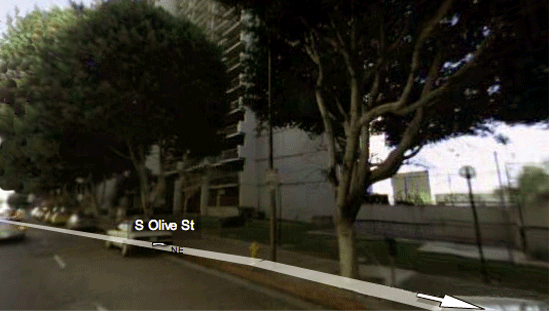
Astoria images courtesy of the Arnold Hylen Collection, California History Section, California State Library
Shot between Astoria and Hillcrest courtesy of the Los Angeles Public Library Photo Collection
Newspaper images from the Los Angeles Times
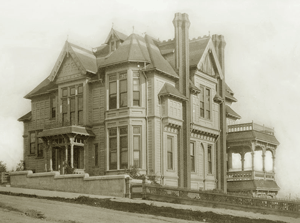 Of all the oft-pictured sites of Los Angeles, Angels Flight is certainly up there amongst them, as who doesn‘t go for those Oldey-Timey images? There‘s probably postcards and ceramic trivets and refrigerator magnets featuring Angels Flight from here to Toledo to Timbuktu, and people probably prefer a pre-1908, pre-Elks Club Building image of the Hill topped with the Crocker Mansion because, again, Oldey-Timey.
Of all the oft-pictured sites of Los Angeles, Angels Flight is certainly up there amongst them, as who doesn‘t go for those Oldey-Timey images? There‘s probably postcards and ceramic trivets and refrigerator magnets featuring Angels Flight from here to Toledo to Timbuktu, and people probably prefer a pre-1908, pre-Elks Club Building image of the Hill topped with the Crocker Mansion because, again, Oldey-Timey. 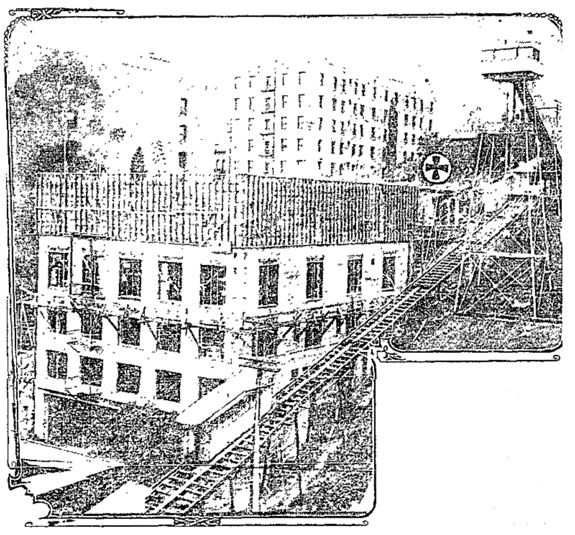
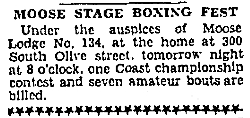
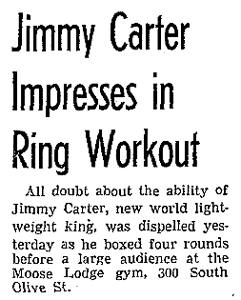
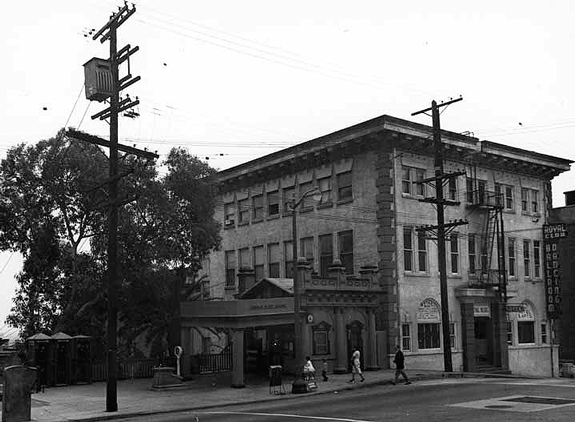
 In its small theater–now roofless and with one wall gone because the workmen‘s hammer– tattered remnants of a once-fancy curtain hang over the stage.
In its small theater–now roofless and with one wall gone because the workmen‘s hammer– tattered remnants of a once-fancy curtain hang over the stage.
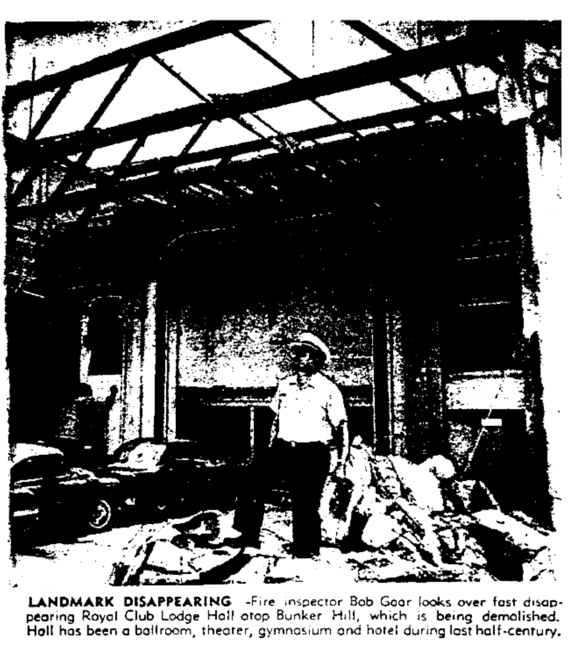




 work! In October of 1911, Astoria resident Mrs. W. F. Sapp returned to her room one afternoon to find”¦nothing amiss. But her mother, Mrs. W. W. Loomis, of the adjoining apartment, called attention to having heard her daughter next door at her writing desk while said daughter was supposed to be absent. They opened the locked writing desk”¦to behold”¦gasp! The chatelaine bag, lockets and bracelets and the like were gone, as was the ancestral family tin box (found later in the lavatory, a can opener found on the fifth floor above) once filled with gold watches, fobs, and diamond-set pieces, now scattered to the underworld of crooked, loupe-wearing bangle merchants.
work! In October of 1911, Astoria resident Mrs. W. F. Sapp returned to her room one afternoon to find”¦nothing amiss. But her mother, Mrs. W. W. Loomis, of the adjoining apartment, called attention to having heard her daughter next door at her writing desk while said daughter was supposed to be absent. They opened the locked writing desk”¦to behold”¦gasp! The chatelaine bag, lockets and bracelets and the like were gone, as was the ancestral family tin box (found later in the lavatory, a can opener found on the fifth floor above) once filled with gold watches, fobs, and diamond-set pieces, now scattered to the underworld of crooked, loupe-wearing bangle merchants.
 Sunday, April 4, 1937. Little Marguerite made a habit of always coming down to the desk to borrow the Sunday paper. This morning she did not. A concerned John Riley, the elevator operator, put an ear to the Wordens‘ door and ascertained a low moan; he summoned Astoria manager J. E. Harrigan, who, with his trusty stepladder, peered through the transom. After what he saw police arrived in short order and even hardened Detective Lieutenants Ledbetter, Bryan and Lopez, after kicking in the door, had to halt in their tracks at the horror that lay in wait.
Sunday, April 4, 1937. Little Marguerite made a habit of always coming down to the desk to borrow the Sunday paper. This morning she did not. A concerned John Riley, the elevator operator, put an ear to the Wordens‘ door and ascertained a low moan; he summoned Astoria manager J. E. Harrigan, who, with his trusty stepladder, peered through the transom. After what he saw police arrived in short order and even hardened Detective Lieutenants Ledbetter, Bryan and Lopez, after kicking in the door, had to halt in their tracks at the horror that lay in wait.  The Wordens’ attacker or attackers had climbed the Angels Flight stairs and forced entry through the kitchen window just below Olive Street. Shoes were removed before climbing in–traces of sock wool were removed from the plaster casts. (The feet, size eleven.) The assailant is almost certainly responsible for the March 2nd rape and brick-administered basal skull-smashing of
The Wordens’ attacker or attackers had climbed the Angels Flight stairs and forced entry through the kitchen window just below Olive Street. Shoes were removed before climbing in–traces of sock wool were removed from the plaster casts. (The feet, size eleven.) The assailant is almost certainly responsible for the March 2nd rape and brick-administered basal skull-smashing of 






